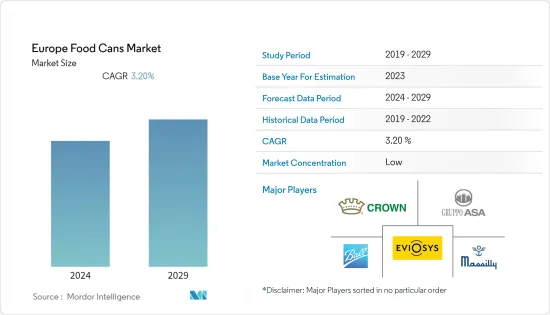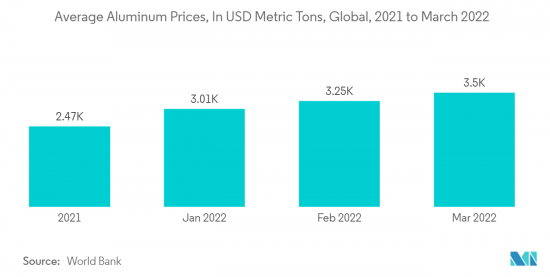PUBLISHER: Mordor Intelligence | PRODUCT CODE: 1408539

PUBLISHER: Mordor Intelligence | PRODUCT CODE: 1408539
Europe Food Cans - Market Share Analysis, Industry Trends & Statistics, Growth Forecasts 2024 - 2029

The Europe food cans market was valued at USD 7.6 billion in 2024 and is expected to be valued at USD 8.96 billion by 2029 with a CAGR of 3.2% over the forecast period. Metal cans play a vital role in preserving food without microbiological spoilage. Cans provide practically complete moisture protection. The cans do not rust and are corrosion-resistant, and they have the extended shelf life of any package. Its advantages include stiffness, stability, and strong barrier qualities.
Key Highlights
- The market is mainly driven by increased demand for packaged and processed foods, expansion of convenient food options, rising demand for milk-based products, rising urbanization, and cans' capacity to be recycled and reused. Increased availability of alternative packaging options and strict government rules regarding safe packaging are significant barriers for the canned food packaging business.
- Many consumers of canned foods choose the products because of the convenience offered and lower cost. Canned foods are convenient and require less energy and cooking time. Most canned foods take 40% less time to prepare than regular meals.
- According to Metal Packaging Europe, Infinite recyclability is the critical factor in defining sustainable food packaging. The European Association for the metal packaging industry evaluated consumer perceptions of canned food and metal packaging in Belgium, Denmark, France, Germany, Italy, the Netherlands, Poland, Spain, and the UK. The survey showed the significance of ensuring consumers and brands fully understand the benefits of food cans to make informed packaging choices that suit their lifestyles and contribute to a more sustainable way of living.
- The industry is also facing challenges with the increase in raw material prices. The cost of aluminum and other materials used in packaging reached new, record levels in the first quarter of 2022, maintaining the strong upward surge in prices, according to Flexible Packaging Europe (FPE). Costs of aluminum have exacerbated deficits in the metal used in the power, construction, and packaging industries.
- With the spread of COVID-19 worldwide, businesses have suffered significantly. The studied market has been negatively impacted due to the pandemic. The COVID-19 pandemic had a mixed impact on the market studied. Some of the effects of the lockdown include supply chain disruptions, lack of availability of raw materials used in the manufacturing process, labor shortages, and fluctuating prices, which led to shipping problems and inflation in the production of the final products. Also, the war between Russia and Ukraine has resulted in economic sanctions against several countries, high commodity prices, supply chain disruptions, and impacts on many markets worldwide, and caused trade disruptions in the industry.
Europe Food Cans Market Trends
Aluminum Cans Expected to Register Largest Market
- Aluminum cans help preserve food quality for a long time. Aluminum cans are completely impervious to oxygen, light, moisture, and other pollutants. They don't rust, are corrosion-resistant, and have one of any package's most extended shelf life. The safety record of aluminum-based food canning is unrivaled. Consumers may rest certain that their items have been safely prepared and delivered as it is tamper-resistant and tamper-evident packaging.
- The recyclability of product packaging is of increasing interest to consumers seeking more sustainable products. As a result, aluminum, which is touted as infinitely recyclable, is gaining traction among product manufacturers and the consumers they serve. Industries transitioning to aluminum include food packaging and other industries. The move to aluminum is reflected in the expected growth of green packaging. The average price of aluminum was USD 3,496 per metric ton in March 2022, which was USD 3,246 per metric ton in February 2022 (World Bank). Various reasons, including the demand for the material in packaging cause such an increase in the price of aluminum.
- Various companies are also focused on recycling aluminum packaging waste. For instance, in May 2023, The Italian-based non-profit National Aluminum Packaging Consortium (CIAL) released last year's results of the country's existing model for managing and recycling aluminum packaging waste. This waste management initiative aligns with the new principles of the European Green Deal's Circular Economy Action Plan.
- The consortium was responsible for collecting and recycling aluminum packaging, and 73.6% of the aluminum packaging waste that entered the market ecosystem was successfully recycled last year. When energy recovery is included in the data, the overall percentage of recovered material further increases to 78%. According to CIAL, this new achievement means that the current recycling rate of aluminum packaging exceeds Italy's pre-set targets for 2025 (50%) and 2030 (60%).
- In October 2022, Ball Corporation launched one of the most sustainable aluminum aerosol cans globally, with only half the carbon footprint of a standard can. This will enable the company's ambition to attain its 2030 science-based targets and net-zero emissions before 2050. The new cans incorporate up to 50% recycled content and low-carbon aluminum smelted using renewable energy sources, such as hydroelectric power. Such innovations by major players drive the market for aluminum in the region.

Food Cans to Witness Growth in Fruits and Vegetables Sector
- The usage of metal cans for the packaging of vegetables is anticipated to witness exciting growth owing to various factors such as increasing health awareness among consumers, increasing implementation of strict rules by the government, for cans to be corrosion-resistant and free from contaminants, such as cadmium Bisphenol-A (BPA), among others.
- An expanding distribution network for canned food items in Europe is anticipated to contribute to market growth. Dedicated online and offline shops for specialty food products are helping to build a significant demand for canned produce. The longevity of canned fruits and vegetables is an important factor supporting the canned vegetables market.
- Regular changes in imports for specific canned products are caused by the size of the harvested raw materials. According to the Ministry of Foreign Affairs, all foods, including canned fruits and vegetables sold in the European Union, must be safe. This applies to imported products as well. Harmful contaminants, such as pesticide residues above excessive levels of mycotoxins or preservatives, are banned.
- The import value of fruit and vegetables in the United Kingdom was GBP 12,304 million (USD 15,536.5 million approximately) in 2022, according to Defra and HM Revenue and Customs. Increased imports of fruits and vegetables would drive the market for metal food cans in the region.
- Moreover, cans and other materials used for packaging must be corrosion-resistant and free from contaminants such as cadmium or bisphenol A (BPA). However, physical and chemical contamination still exists. Companies operating in the region need to follow such requirements in the region.
- Various countries in the region are banning the plastic material for packaging. For instance, recently, implementing a February 2020 law, the government published a list of 30 fruits and vegetables that must be sold without plastic packaging. The vegetables include peppers, cucumbers, potatoes, carrots, cauliflowers, squashes, parsnips, radishes, and more. Fruits such as apples, pears, oranges, kiwis, lemons, citrus, melon, and more are also included. Such bans would further leverage the market for food cans in the region.
Europe Food Cans Industry Overview
The competitive rivalry in the European food cans market is high owing to many key players continually trying to gain maximum market share through collaborations, promotions, investments, and more. Some of the major players are Crown Holdings, Inc., Ball Corporation, Silgan Holdings Inc., Massilly Holdings SAS, ASA Group, Eviosys Packaging Switzerland, and more.
In September 2022, Crown Holdings Inc. partnered with Ardagh Metal Packaging, the Can Manufacturers Institute, and more to host the first Global Aluminium Can Sustainability Summit. The Summit brought together more than 100 global attendees from different parts of the aluminum supply chain, such as primary material suppliers, packaging manufacturers, research organizations, and beverage brands. The Summit facilitated essential discussions to drive actionable progress toward the aluminum industry's sustainability goals.
Additional Benefits:
- The market estimate (ME) sheet in Excel format
- 3 months of analyst support
TABLE OF CONTENTS
1 INTRODUCTION
- 1.1 Study Assumptions and Market Definition
- 1.2 Scope of the Study
2 RESEARCH METHODOLOGY
3 EXECUTIVE SUMMARY
4 MARKET INSIGHTS
- 4.1 Market Overview
- 4.2 Industry Value Chain Analysis
- 4.3 Industry Attractiveness - Porter's Five Forces Analysis
- 4.3.1 Bargaining Power of Suppliers
- 4.3.2 Bargaining Power of Buyers
- 4.3.3 Threat of New Entrants
- 4.3.4 Threat of Substitute Products
- 4.3.5 Intensity of Competitive Rivalry
- 4.4 Impact of Ukraine-Russia Standoff on the Market
5 MARKET DYNAMICS
- 5.1 Market Drivers
- 5.1.1 Increased Barrier Properties Against Temperatures and Pressure
- 5.1.2 Quick and Easy Solution for Modern Lifestyles
- 5.2 Market Restraints
- 5.2.1 Increased Cost of Raw Materials
6 MARKET SEGMENTATION
- 6.1 By Material Type
- 6.1.1 Aluminium Cans
- 6.1.2 Steel Cans
- 6.2 By Application
- 6.2.1 Ready Meals
- 6.2.2 Powder Products
- 6.2.3 Fish and Seafood
- 6.2.4 Fruits and Vegetables
- 6.2.5 Processed Food
- 6.2.6 Pet Food
- 6.2.7 Other Applications
- 6.3 By Country
- 6.3.1 United Kingdom
- 6.3.2 Germany
- 6.3.3 France
- 6.3.4 Spain
- 6.3.5 Italy
- 6.3.6 Rest of Europe
7 COMPETITIVE LANDSCAPE
- 7.1 Company Profiles
- 7.1.1 CANPACK S.A. (CANPACK Group)
- 7.1.2 Crown Holdings, Inc.
- 7.1.3 CPMC Holdings Limited
- 7.1.4 Silgan Holdings Inc.
- 7.1.5 Eviosys Packaging Switzerland
- 7.1.6 Massilly Holding SAS
- 7.1.7 Ball Corporation
- 7.1.8 ASA Group
8 INVESTMENT ANALYSIS
9 FUTURE OF THE MARKET




